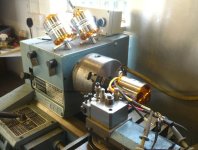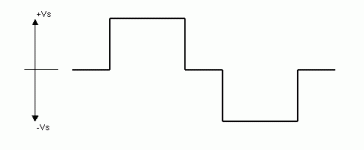Tiberius
10 kW
OK, some of you may already know the answer to these questions, in which case this post will tell you more about me than about motors.
Kv is the rpm per Volt. I'm talking about Permanent Magnet Brushless DC motors, but the principle applies to other types. Ie, Kv tells you how fast the motor can run at no load from a given voltage. Or its the back emf at a given rpm. Basically, it tells you the relationship between the rpm and voltage on the terminals, when there is no current flowing.
But this is a 3 phase system, with approximately sinusoidal waveforms. I've always wondered if Kv is defined in terms of the peak voltage, the rms voltage, or the peak to peak voltage. And whether it's measured from phase wire to phase wire or phase wire to the neutral position (similar to the familiar delta-wye argument). Or is it some bizarre definition based on the 6 step waveform?
Anyone else would look it up, or find a good forum to ask on. Being me, I tried to measure it. In theory, its simple enough to spin the motor up to a given rpm and measure the voltage. I did it by mounting a motor in a lathe and connecting it to a scope.
I had to make a little filter circuit to remove all the interference from the 3 phase variable frequency drive I fitted to the lathe, but other than that it all worked fine. I'm testing a Turnigy C63-64, which has 12 stators and 14 magnets. For this type of motor,the number of stators has to be a multiple of 3 and the number of magnets a multiple of 2. Its usual to make the magnets number the next convenient one up from the stators. 14 magnets is 7 pole pairs, so the frequency generated should be 7 times the rate the shaft is turning.
I tested 3 motors at the same speed and got the same results from each.
Update: I went back and rechecked the rpm measurement. I set the scope to trigger off the line waveform (50 Hz in my country) and adjusted the lathe to get 50 Hz from the motor. With a 7 pole pair motor, this means a shaft speed of 429 rpm. The lathe settings worked out as 409 rpm, so that's close enough.
Nick
Kv is the rpm per Volt. I'm talking about Permanent Magnet Brushless DC motors, but the principle applies to other types. Ie, Kv tells you how fast the motor can run at no load from a given voltage. Or its the back emf at a given rpm. Basically, it tells you the relationship between the rpm and voltage on the terminals, when there is no current flowing.
But this is a 3 phase system, with approximately sinusoidal waveforms. I've always wondered if Kv is defined in terms of the peak voltage, the rms voltage, or the peak to peak voltage. And whether it's measured from phase wire to phase wire or phase wire to the neutral position (similar to the familiar delta-wye argument). Or is it some bizarre definition based on the 6 step waveform?
Anyone else would look it up, or find a good forum to ask on. Being me, I tried to measure it. In theory, its simple enough to spin the motor up to a given rpm and measure the voltage. I did it by mounting a motor in a lathe and connecting it to a scope.

I had to make a little filter circuit to remove all the interference from the 3 phase variable frequency drive I fitted to the lathe, but other than that it all worked fine. I'm testing a Turnigy C63-64, which has 12 stators and 14 magnets. For this type of motor,the number of stators has to be a multiple of 3 and the number of magnets a multiple of 2. Its usual to make the magnets number the next convenient one up from the stators. 14 magnets is 7 pole pairs, so the frequency generated should be 7 times the rate the shaft is turning.
I tested 3 motors at the same speed and got the same results from each.
Update: I went back and rechecked the rpm measurement. I set the scope to trigger off the line waveform (50 Hz in my country) and adjusted the lathe to get 50 Hz from the motor. With a 7 pole pair motor, this means a shaft speed of 429 rpm. The lathe settings worked out as 409 rpm, so that's close enough.
Nick




